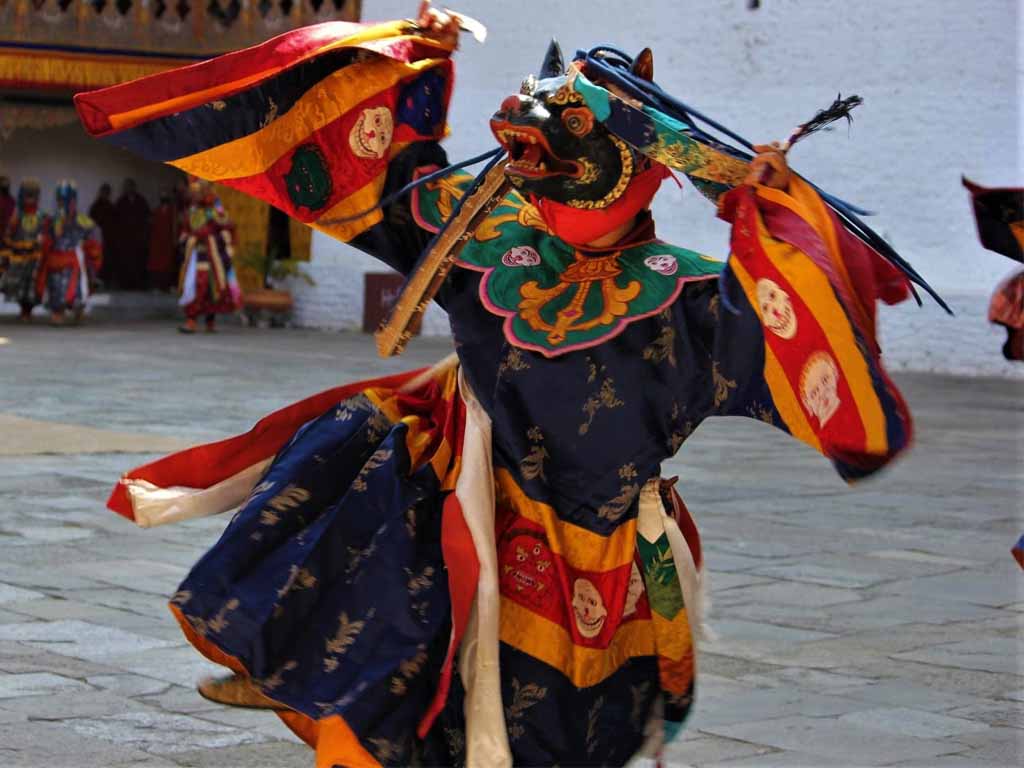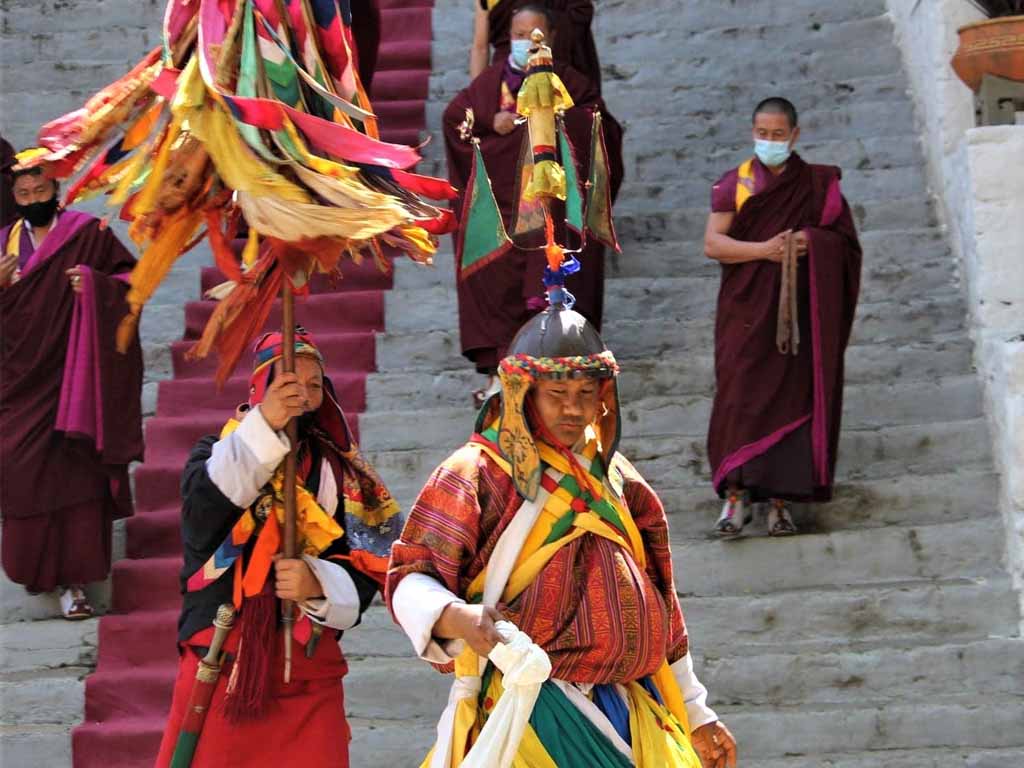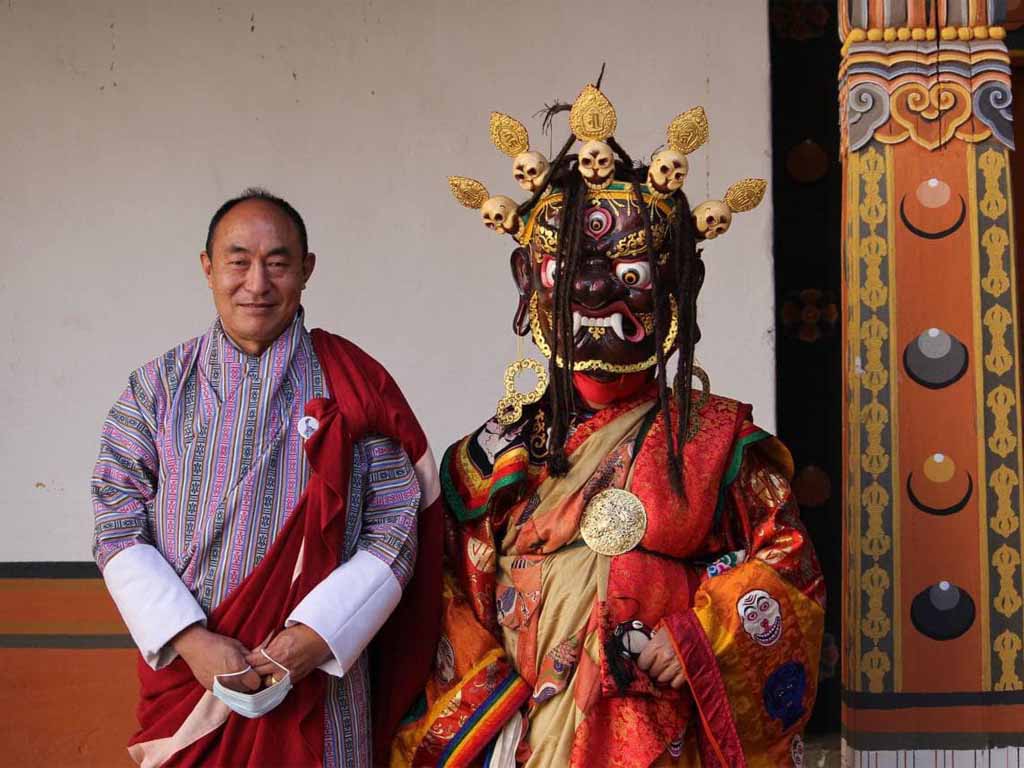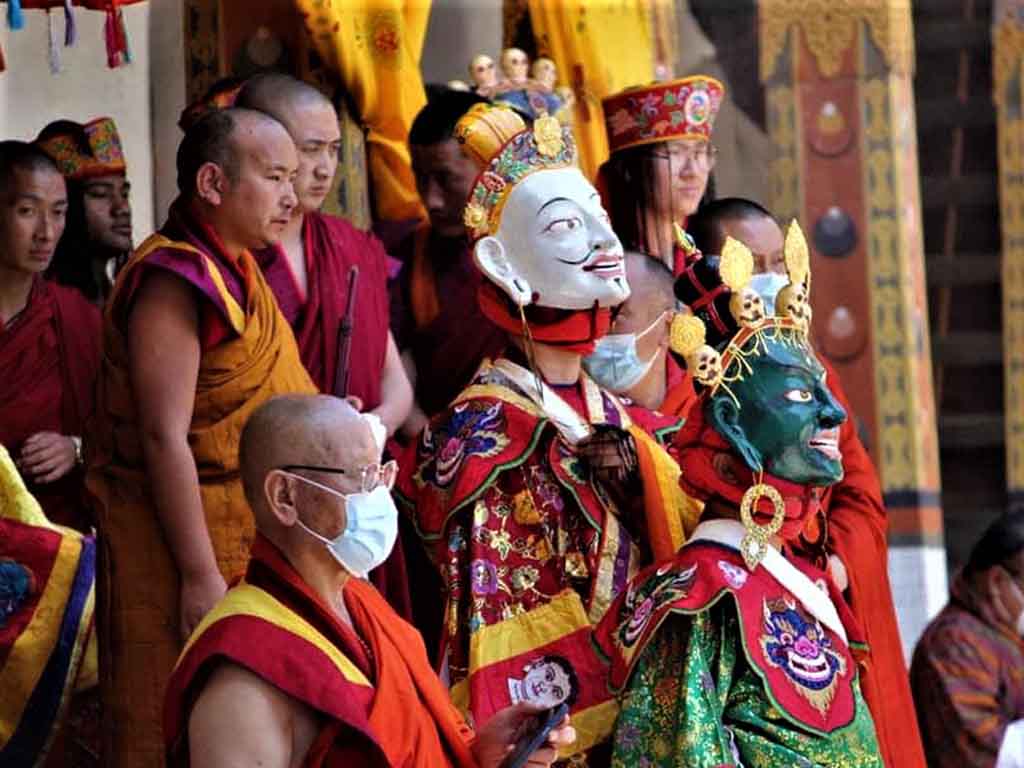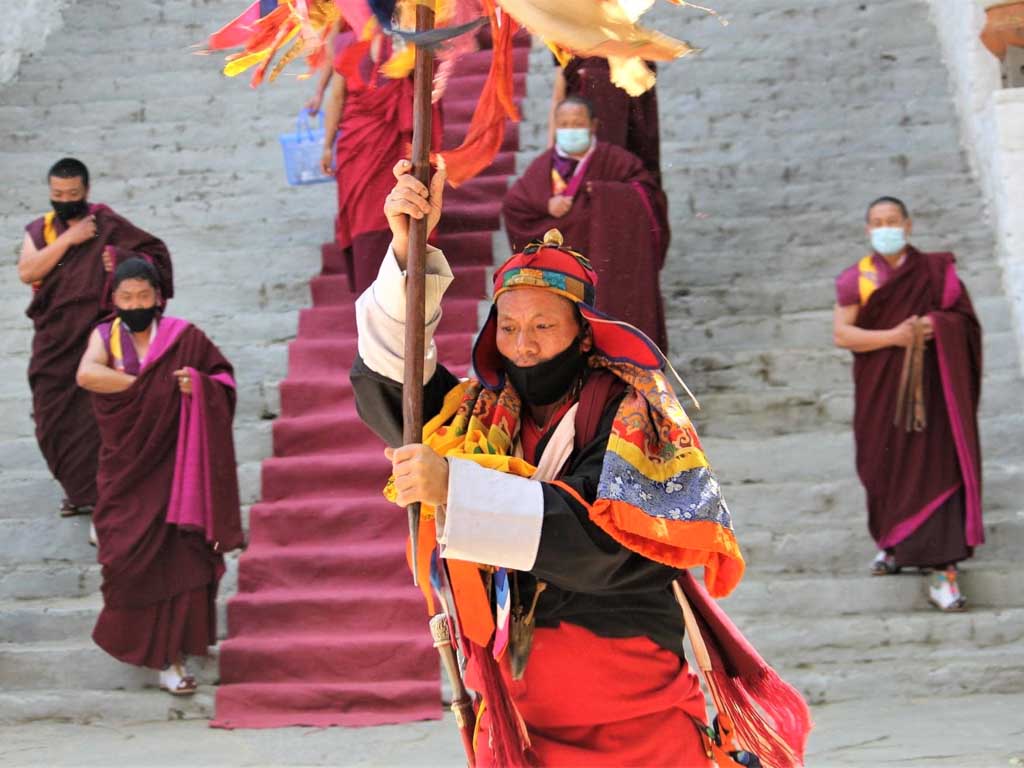Punakha Drupchen
Punakha Drupchen is an annual festival celebrated for about 3 days usually in the month of February or March. It’s a spectacular celebration of the 17th-century triumph of Bhutanese armies over Tibetan invaders. Palden Lhamo, Bhutan’s patron god, is also honored throughout the festival.
The Punakha Dzong comes to life with the sound of trumpets, drums, and cymbals during Punakha Drupchen. The festival’s high point is a reenactment of old battle scenes, in which actors in period costumes portray the victory of the Bhutanese army.
This Journey of 8 nights allows you to experience 4 beautiful Valleys of Bhutan. The journey starts in Thimphu, then takes you to Punakha, Gangtey and finally to Paro where you will end your journey.
![]() Duration: 8 Nights/ 9 Days
Duration: 8 Nights/ 9 Days
![]() Location:Thimphu-Punakha-Gangtey-Paro
Location:Thimphu-Punakha-Gangtey-Paro
Day 01: Paro – Thimphu (55kms/1.5 Hours)
The flight into Bhutan takes you close to the great Himalayas, offering dazzling scenic views of some of the world’s highest glacial peaks. As you enter Paro valley, you will sweep past forested hills with the silvery Pa Chu (Paro river) meandering down the valley below. Paro Dzong (fortress) and Ta Dzong (watchtower) on the hills above the town will be a fine sight. Our representative will receive you and will drive to Thimphu with sightseeing along the way.
Drive towards the capital city, Thimphu.
- Visit National Memorial Chorten: The building of this landmark was envisaged by the third king, His Majesty Jigme Dorji Wangchuck, as a monument to world peace and prosperity. Completed in 1974 after his untimely death, it is both a memorial to the Late King (”the father of modern Bhutan “) and a monument to world peace. The paintings and statues inside the monument provide a deep insight into Buddhist philosophy.
- Evening visit Tashichho Dzong the impressive fortress which houses the secretariat building, the throne room of His Majesty the King and various government offices. It is also the summer residence of the Chief Abbot and central monk body. Witness the Flag lowering ceremony before you enter the Dzong.
Overnight at Hotel in Thimphu
Day 02: Thimphu
- Drive to Kuenselphodrang where world’s tallest Buddha Statue (169 feet) sits overlooking the Thimphu valley. Enjoy the spectacular view of Thimphu city.
- Visit the zoo at Motithang to gaze upon Takin, the National animal of Bhutan.
- Drive down to the view point of Tashichho Dzong, the impressive fortress which houses the secretariat building, the throne room of His Majesty the King and various government offices.
- Folk Heritage Museum.
- General Post Office where you can make a postage stamp with your own picture which can be posted within Bhutan.
- Evening free for shopping.
Overnight at hotel in Thimphu.
Day 03: Thimphu- Phobjikha (135kms/5hours)
Drive via Dochu-lapass(3,088m/10,130ft) stopping briefly here to take in the view and admire the 108chortens, maniwall, and prayer flags which decorate the highest point on theroad.
If skies are clear, the high Himalayan peaks towards the north east will be revealed in all their glory. On a clear day, the following peaks can be seen from this pass (left to right): Masagang (7,158m), Tsendegang (6,960m), Terigang (7,060m), Jejegangphugang (7,158m), Kangphugang (7,170m), Zongaphugang (7,060m) a table mountain that dominates the isolated region of Lunana, and finally, Gangkar Puensum, the highest peak in Bhutan at 7,497m.
- On the way stop at Punakha/Nobding for Lunch.
- After Lunch, proceed to Phobjikha, one of the most pleasant glacial valleys in Bhutan.
Gangtey (Phobjikha Valley): The valley is popular for its scenic splendor and cultural uniqueness. Phobjikha is well known as the winter home of the Black-Necked Cranes (Grus Nigricollis), that migrate from the Tibetan plateau. The birds can be observed from early November to end of March. Overlooking the valley is the Gangtey Goenpa.
Gangtey Valley Exploration
- The most beautiful and shortest of the existing nature trails in Bhutan. The trail hike starts from the Mani (like Chorten) stone wall to the north of the Gangtey Gonpa and ends in Khewa Lhakhang. The hike takes about 1hr 30minutes through the pine forest and small bamboo plants. You can see the Phobjikha valley so beautifully from this hike. It is one of the best hike places for the Nature lovers. During the winter months, we can see the endangered species of birds – Black Neck Cranes.
- Rest of the day at leisure- explore the valley or soak yourself in a traditional hot stone bath!
Overnight at hotel in Phobjikha
Day 04: Gangtey- Punakha (78kms/3hours)
Take a serene Drive to Punakha
Visit Punakha Dzong, a massive structure built at the junction of two rivers. Punakha was Bhutan’s capital until 1955 and Punakha Dzong still serves as the winter residence of the central monk body. Bhutan’s first king, Ugyen Wangchuck, was crowned here in 1907. The fortress has withstood damage from fire, earthquake and flood over the centuries. The latest flood, in October, 1994, caused great damage to the fortress but miraculously spared its most holy statue.
Witness Punakha Drubchen
Punakha Drubchen is the unique festival with a “Ser Da” procession that re-enacts the war that was fought against Tibetan in the 17th century
Hike to Chimi Lhakhang through a nice walk along the rice field and through farm houses. The temple was built by Lama Ngawang Chogyel in 1499 and is today a popular temple where barren women come to pray for a child. The temple is popularly known as the Fertility Temple.
Overnight at hotel in Punakha.
Day 05: Witness Punakha Tshechu
Festival & it’s Significane
Festival (Tshechu) meaning the tenth day of a month in a Bhutanese lunar calendar is a special occasion for the Bhutanese. It is usually held for 3 days – 5 days on a tenth day of a month coinciding with the birth anniversary of Guru Rinpoche (The Second Lord Buddha) who is credited in Bhutan for introducing Tantric Vajrayana Buddhism in Bhutan. It is performed to honor Guru Rinpoche. The families gather together and takes a picnic lunch from home and set out to witness the festival. The Bhutanese try to look their best in their traditional attire which is called as Gho for men and Kira for women. Costumes worn by the people and the mask dancers are both very colorful. People from all age group comes to witness the festival. Different segments of mask dances will be performed followed by Traditional folk dance during each break.
- Today is a special day for you as you will witness one of the most awaited festival for the Bhutanese. You will see the local people wearing the traditional dresses called as “Gho” for men and “Kira “for women with different designs and intricate patterns. The colors of the Mask dancer and the traditional folk music all makes it even more interesting to be there. The clowns called as Atsara (Acharya for Sanskrit meaning the master) will entertain you throughout the day with some objects in their hand and a phallus hanging from the top of their mask ready to fly over the women. Different kinds of dances will be portrayed followed by Traditional folk dance. You can mingle with the people and you can notice yourself not being able to keep your camera away from you.
After a good lunch and some break drive back to the courtyard. It will still amaze you with many more different mask dances to be displayed.
Day 06: Punakha- Paro (140kms/5hours)
Take a scenic drive back to Paro. On the way back you can drop by Royal Botanical Park, Lamperi. It is a breath taking 125 acres’ botanical garden with 46 species of rhododendron flower. You can choose to boating here. The best time to visit this place will be between April and June. The park also has trekking routes, walk around the Baritsho lake, tree house and camping space for visitors. The annual rhododendron festival is held here.
National Museum of Paro, once a watchtower, built to defend Rinpung Dzong during inter valley wars of the 17th century, Ta Dzong was inaugurated as Bhutan’s National Museum in 1968. It holds fascinating collection of Arts, relics, religious thangkas paintings and Bhutan’s exquisite postage stamp.
Paro Rinpung Dzong meaning the fortress on the heap of jewels or the fort of Paro.
Visit Namgay Artisanal Brewery where they brew many styles of beers considering the different drinking palates for taste, making sure that all beer-lovers are satisfied. This added to the innovative nature of craft brewers all over the world have taken the market by storm, allowing them always to brew something new.
Evening free or can visit the Paro town with a street of typical Bhutanese traditional buildings.
Overnight at your Hotel in Paro.
Day 07: Paro Taktshang Hike (4-6hours)
Today you will be hiking to one of the famous sites called as the Tiger’s Nest (Taktshang) perched at 900m above the Paro valley.
It is a pilgrimage site which the Bhutanese try to visit at least once in a lifetime. It is believed that Guru Rinpoche flew on the back of a tigress from eastern Bhutan to this site and meditated in a cave here for 3 months, hence its name, ‘Tiger’s Nest’. The site, which has long been regarded as the sacred place, was visited by Shabdrung Ngawang Namgyel in the 17th century approximately in 1646. The Lhakhang of the present monastic complex dates from 1692. The main structure was severely damaged by fire in 1998, but with the help of the local people and the government it has been put back to its glory.
The hike can be broken down into various stages
The first stage is the trek to the cafeteria (where lunch will be served later today) which is situated on a rocky outcrop across a ravine from the monastery. This leg of the trek takes approximately 45 minutes to 60 minutes, depending on your level of fitness. At the Cafeteria we can stop for some tea or coffee and biscuits whilst pondering the journey ahead and looking at the monastery I the distance above us.
The 2nd stage of the walk is from the cafeteria to the lookout opposite of the monastery. This leg takes close to one hour. At this point some may be content to snap photos and return to cafeteria.
The next stage is the trek/climb down the 475 steps in the cliff face to the bottom of the ravine which crosses over a stream and a waterfall before the path again ascends another 300 odd steps to the entrance of the monastery. Once here we should be able to enter into the monastery and view the cave where Guru Rinpoche meditated. (Cameras are not allowed inside the monastery).
- Kichu monastery. It is the oldest and one of the first ever Buddhist monastery built in Bhutan.<
Day 08: Departure
End of your travel to Bhutan. Our team will drive you to the Airport and bid farewell.
Festival Date
Feb – 16 to Feb -18, 2024
TOUR HIGHLIGHTS
Punakha Drubchen
- Immerse in the festive atmosphere with drums, cymbals, and traditional music; locals in traditional attire of the Punakha Drubchen.
- Witness the dramatic reenactment of historical battle scene by men in warrior attire (pazaps).
- Witness the religious ceremonies with sacred masked dances (cham) performed by monks in Punakha Dzong.
- Visual Delight: Get your camera ready to capture the visually stunning moments of the mask dances. Focus on the intricate details of the masks, the graceful movements of the performers, and the synchronized choreography.
Hike – ( The signature spot of Bhutan)
- Embark on an unforgettable journey to Bhutan’s iconic Tiger’s Nest monastery, perched dramatically on a cliff.
Culinary delights not to be missed!
- Indulge in the flavors of Bhutan with authentic cuisine like Ema Datshi, Momos, and Ara—culinary delights not to be missed!
Enchanting Valleys of Bhutan: Phobjikha, Punakha, Thimphu, and Paro
- Phobjikha valley: Experience the glacial splendor of Phobjikha valley, a picturesque valley known for its breathtaking beauty and serene ambiance.
- Punakha valley: Explore the golden Punakha valley, where the vibrant and visually splendid Punakha Drubchen festival takes place at the majestic Punakha Dzong courtyard.
Thimphu – the cpital of Bhutan: Discover the wonders of Thimphu Valley, where ancient traditions meet modernity amidst captivating landscapes.
Paro Valley: Discover Paro Valley, home to Bhutan’s only international airport and the iconic Tiger’s Nest monastery—an enchanting blend of nature and spirituality.
PACKAGE COST FROM
$ 2280
Package cost :
USD 2280 per Person basis on double sharing basis
Single Room Supplement:
USD 40 per Person and per Night
PACKAGE INCLUSION
Sustainable Development Fee to the Government of Bhutan which goes towards the development of schools. hospitals. etc.,
Bhutan Visa
Accommodations in 3- star properties. (Can be upgraded to 4 & 5-star with additional Premium)
All Meals (Breakfast, Lunch & Dinner)
Certified English Speaking Bhutanese Guide.
All ground transportation
All internal taxes and charges including Entry Fees
Mineral Water while traveling
Complimentary from company:
Traditional Hot Stone Bath
PACKAGE EXCLUSION
Airfare (can be arranged with us)
Travel Insurance
Any Expenses of Personal Nature
Tips for the guide and driver


